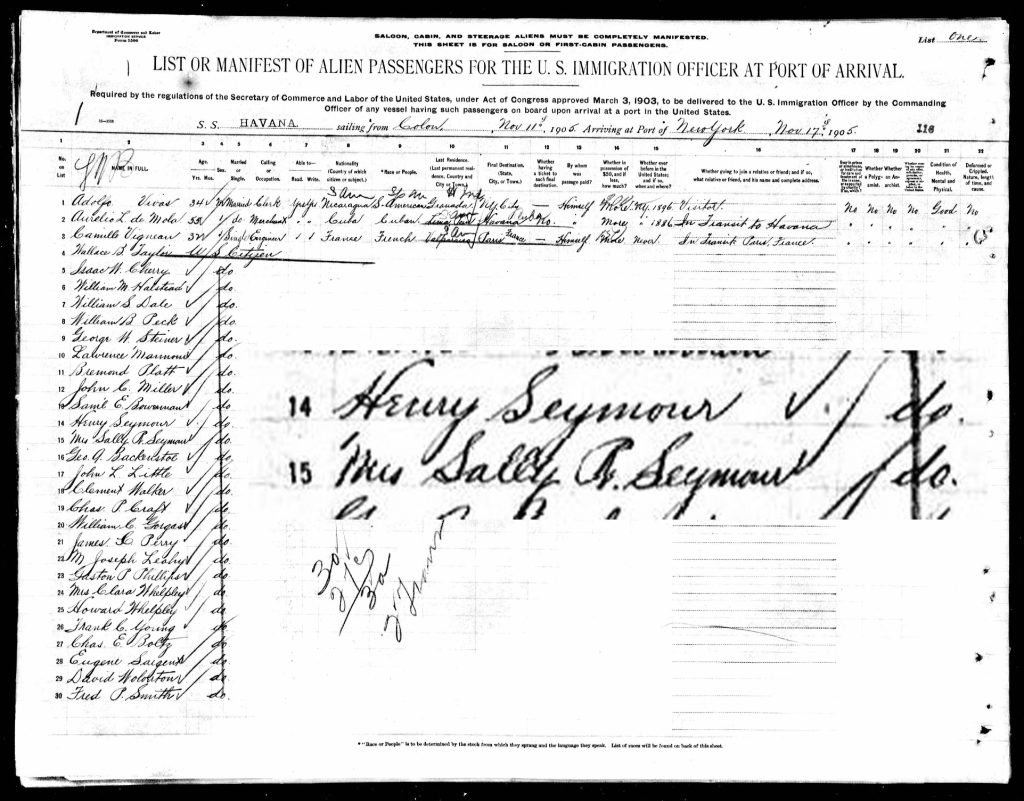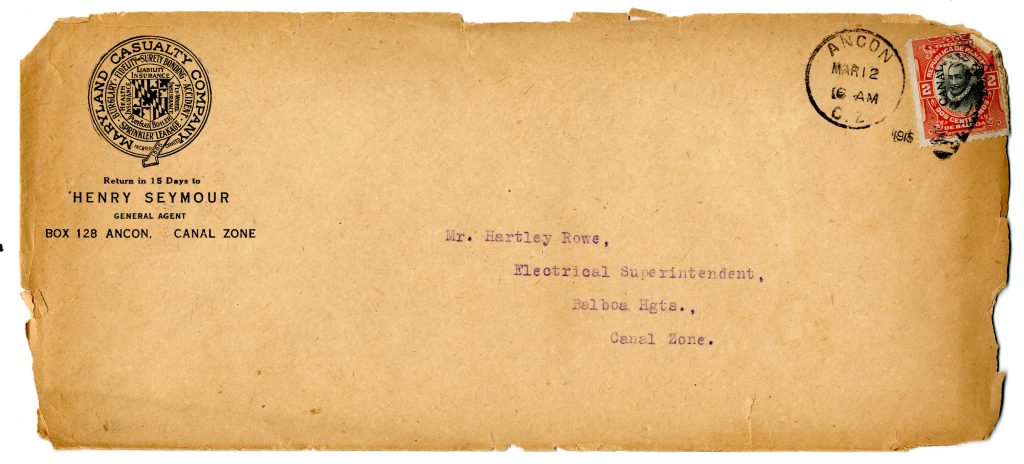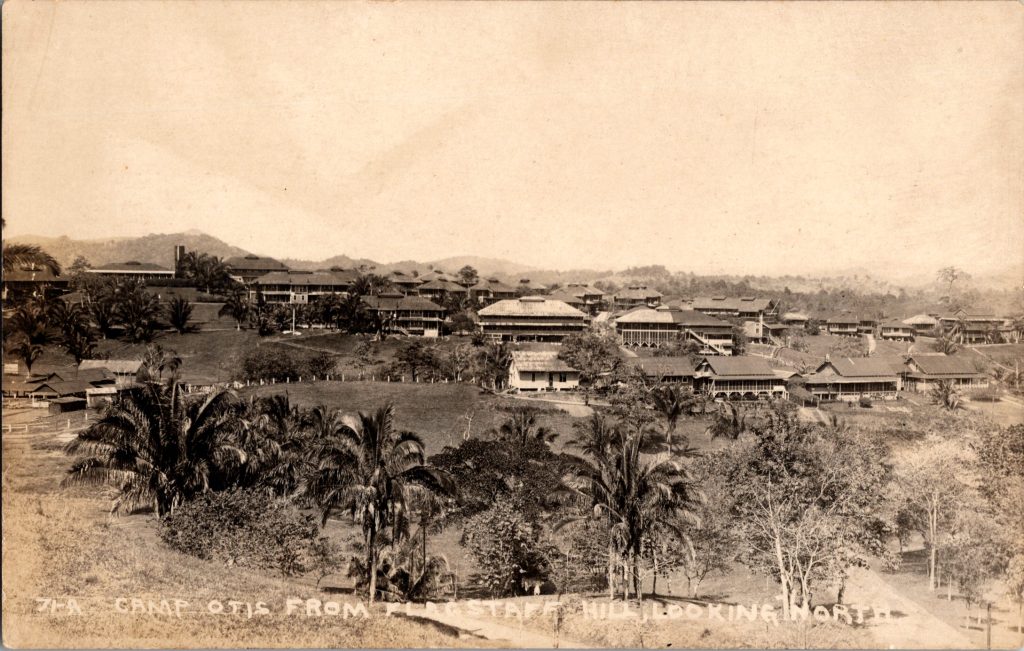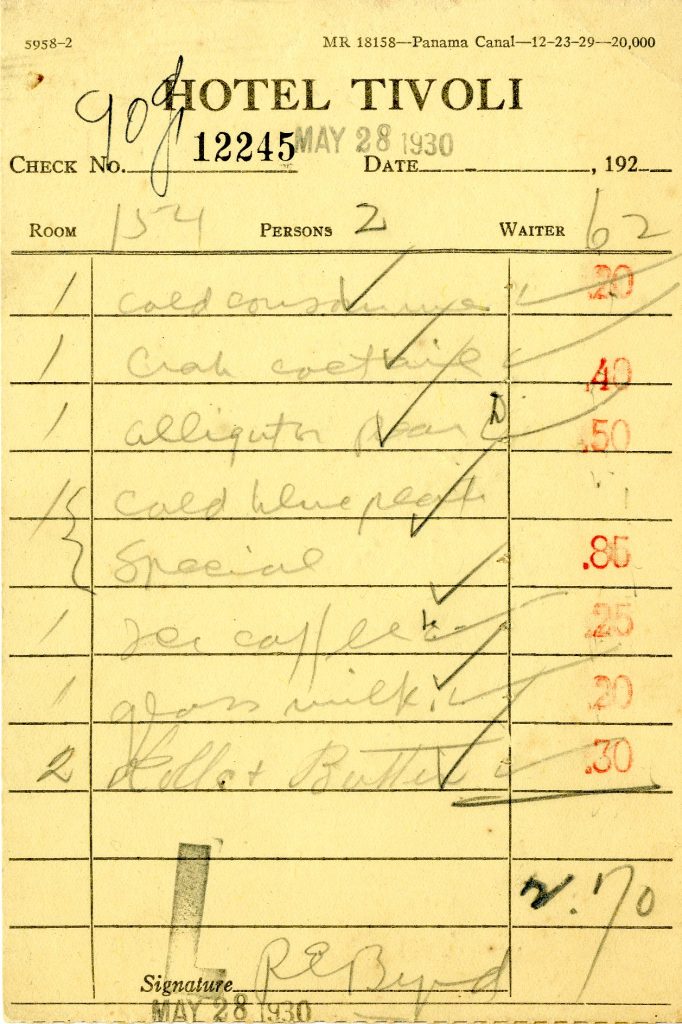-
Insurance on the Isthmus

Balboa High School, Parakeet, October 9, 1954 How was coverage at one of the world’s biggest construction sites?
Earlier this year we had the pleasure of doing an oral history interview with Don Randel, Balboa High School Class of 1958. He told us about his family’s connection to the Panama Canal and a unique element of the construction days – insurance.
Don’s aunt and uncle, Sally and Henry Seymour, arrived on the Isthmus during the construction of the Canal. Sailing records indicate they went back and forth from Panama a few times before finally settling down and opening their insurance business, Seymour Agency, around 1913. Don remembers that it started off providing workers insurance for Canal employees.

Sailing record from the S.S. Havana. Leaving Colon on November 11, 1905 and arriving in New York on November 17, 1905. We enlarged the names of Henry and Sally so you could see them. 
While we were working on this blog post we got a donation of a large group of old envelopes associated with the Panama Canal. We couldn’t believe that one of them was from Henry Seymour! And it was addressed to Hartley Rowe, the engineer we featured in the Manhattan in Panama blog post a few months ago. What timing! According to their Certificate of Registration, Henry and Sally lived in Camp Otis in 1914, before they later moved into more glamorous quarters (hint…it is a well known hotel on the Pacific side).
Henry Seymour passed away in 1927, but Sally kept the business going, running it out of the Tivoli Hotel until the 1940s when she decided to retire and asked Don’s father to take over the business.
Use the arrows on the left and right to click through the slideshow of U.S. Census records that include Henry and Sally Seymour living at the Tivoli.
Sally could often be seen on evenings in the dining room of the Tivoli with her beloved cocker spaniel Chica.
Listen to Don talk about his aunt and uncle and the insurance agency.
Use the left and right arrows to flip through the slideshow below to see a few Tivoli Hotel items and photos. According to the menu, Sally probably paid 50 cents for her scotch on the rocks (listen to the clip if you don’t know what this means).
The Panama American includes a notice of Sally’s farewell party in March 1946 as she prepared to permanently return to the United States. Sadly, only a few days later, the same paper shared the news of her unfortunate passing in New Orleans, part way through the voyage.
Follow the coverage of Sally’s departure and funeral service through this gallery of clips from the Panama American newspaper. (Issues: March 2, 8, 14, 20, 24, 1946)





Most of the early 20th century issues of the Panama American were digitized through funding generously provided by a family of long-time supporters of the Panama Canal Museum and the PCMC here at UF. This newspaper is one of the most utilized items in the PCMC collection and has been viewed over 13 million times.
Don’s father ran the Seymour Agency for many years and Don spoke of fond memories visiting the agency office which his father had moved into Panama City. Under his father’s ownership the agency sponsored baseball, bowling, and cricket teams.
In his interview Don talked about some of those sports teams and his own Little League team, the Firemen. We have a wonderful photo of the 1952 team that includes Don among the ranks.
Listen to a clip about sports from Don’s interview.

1952 Little League Firemen Team. A handwritten caption on the back of the photo lists the names of some coaches and players. Back Row Coaches: Huddleston, ? ; Middle Row Players: Richard Morris, ?, Ted Webb, Fred Dube, John Chase, ?, Mo Shoch, Don Randel; Front Row: ?, ?, Jim Price, ?, ?, Frank Townsend, ?, ?, ?. Gift of Frank Townsend. II.2019.39.5 Can you help us identify anyone else?
Stay tuned to hear more from Don’s interview in our next post. It might make you want to break out your old records and dance...
This post is part of our fall focus on the important work of the Panama Canal Museum and on the oral history program they began and which continues today. This year is the 25th anniversary of the founding of the Panama Canal Museum in 1998. The museum operated for 14 years in Seminole, Florida, before closing in July 2012 and transferring its collection to UF. The successes achieved by the museum paved the way for the PCMC to develop as a preeminent research collection for the study of the American era of the Canal. For more information on the history of the Museum, please visit go.ufl.edu/pcm
Between now and the end of December, we are celebrating their 25th Anniversary and hope to honor their hard work as well as that of our Friends of the PCMC group by adding $13,000 to the $12,000 that was raised by this year’s Silent Auction for a total of $25,000 – $25,000 for 25 amazing years!
If you would like help us reach the goal please donate here: https://pcmc.uflib.ufl.edu/oralhistory/. All funds will go to support the PCMC oral history program.
-
Audio Clips (and more) about Amador
Congratulations to our friends at the Biomuseo who debuted their exhibit Amador: Ayer y Hoy earlier this year. The exhibit consists of 48 panels displayed throughout the Amador Causeway and explores its history from creation during the construction of the Canal and service as a military installation through its use today as a public place for everyone to enjoy.
When the team from the Biomuseo was working on the exhibit in 2022 they came to the University of Florida for a week to conduct research. Many photographs from the PCMC collection can be seen on the panels in Panama! Their visit coincided with our annual luncheon so they were also able to meet members of the Panama Canal Society and the Friends of the Panama Canal Museum Collection and they later interviewed many about their memories of Amador and the causeway. Numerous quotes from those interviews are featured throughout the exhibit. We are working with the Biomuseo on the long term preservation of the full interviews.

Image provided by the Biomuseo The exhibit explores many different facets of the history of the causeway: history, fishing, music, art, and biodiversity to name a few.
The land that was occupied by Fort Amador and the causeway that was once part of Fort Grant were created with material excavated during the construction of the Panama Canal. The area of Fort Amador was known as the “Balboa Dump” and was originally covered by water. The causeway served as a breakwater for the Pacific entrance of the Canal, and also connected the Canal Zone to the “fortified islands” of Naos, Culebra, Perico, and Flamenco which housed important defense installations. The railroad that had been used to build the breakwater was originally left in place to move ammunition and other military equipment.

These early photos show some of the different phases of construction Click on an image to enlarge it.
Amador, the causeway, and particularly the Officer’s Club were a big part of life for many. The Amador Officer’s Club housed high school dances, many enjoyed fishing off the causeway, and swimming at the beach club.
Enjoy the following clips from our oral history collection.
Interview with Malena, Didi, and Fred Bremer, https://ufdc.ufl.edu/aa00013365/00001 
Panama Canal Review, October 1952 Interview with Jose Vanga, https://ufdc.ufl.edu/aa00040427/00001 
Postcard of Fort Amador, II.2021.36.106 
The Tropic Times, June 15, 1990 
During a recent trip to Panama we had the pleasure of spending a wonderful morning with our Biomuseo friends who showed us around the causeway, the old Officers Club which is now their work space, and gave us a great drive-by tour of some iconic buildings in the former Canal Zone.
Visit the virtual exhibit to hear some of the clips (https://biomuseo.org/amador/) and next time you are in Panama, stop by the causeway, enjoy the beautiful view, and explore the exhibit which was funded by the public diplomacy grant program of the United States Embassy in Panama.
Panel number 31 is pretty fun…
The fabulous team at the Biomuseo is putting the finishing touches on the next exhibit which will go up in Ciudad del Saber, which occupies the land that was formerly Ft. Clayton.
What are your favorite memories of the causeway?

Panama Canal Review, October 1979
This post is part of our fall focus on the important work of the Panama Canal Museum and on the oral history program they began and which continues today. This year is the 25th anniversary of the founding of the Panama Canal Museum in 1998. The museum operated for 14 years in Seminole, Florida, before closing in July 2012 and transferring its collection to UF. The successes achieved by the museum paved the way for the PCMC to develop as a preeminent research collection for the study of the American era of the Canal. For more information on the history of the Museum, please visit go.ufl.edu/pcm
Between now and the end of December, we are celebrating their 25th Anniversary and hope to honor their hard work as well as that of our Friends of the PCMC group by adding $13,000 to the $12,000 that was raised by this year’s Silent Auction for a total of $25,000 – $25,000 for 25 amazing years!
If you would like help us reach the goal please donate here: https://pcmc.uflib.ufl.edu/oralhistory/. All funds will go to support the PCMC oral history program.


















